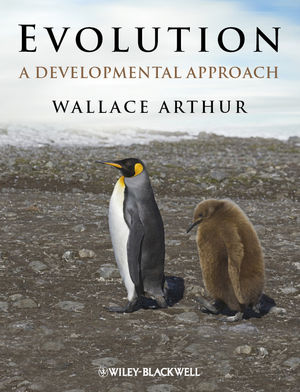Evolution: A Developmental ApproachISBN: 978-1-4051-8658-2
Paperback
418 pages
January 2011, Wiley-Blackwell
 This is a Print-on-Demand title. It will be printed specifically to fill your order. Please allow an additional 10-15 days delivery time. The book is not returnable.
Other Available Formats: Hardcover
|
||||||
PART I Foundations 3
1 Introduction 4
1.1 From Darwin to Development 4
1.2 Development; and Evolutionary Changes in Development 9
1.3 Development and the Realm of Multicellularity 11
2 What is Evo-Devo? 15
2.1 Forerunners of Evo-Devo 15
2.2 Nineteenth-Century Comparative Embryology 16
2.3 Diverse Antecedents—1900–1980 19
2.4 Conclusions from History; Messages for the Present 24
2.5 The Advent of Evo-Devo in the 1980s 25
2.6 Broad and Narrow Views of Evo-Devo 27
2.7 Too Few Laws, Too Many Facts? 28
3 Development, Cells and Molecules 34
3.1 Analysing the Developing Organism 34
3.2 Cells and Development: The Basics 37
3.3 Genes: Structure, Expression and Developmental Function 40
3.4 Signalling Pathways Within and Between Cells 45
3.5 Signalling: From Cell to Embryo 48
3.6 Long-Range Signalling and Developmental Processes 51
4 Natural Populations 54
4.1 The Ecological Theatre and the Evolutionary Play 54
4.2 Types of Creature; Types of Population 55
4.3 Spatial Structure 60
4.4 Age Structure 64
4.5 Genetic Structure 65
4.6 Natural Selection 67
PART II Developmental Repatterning 75
5 Mutation and Developmental Repatterning 77
5.1 Mutation in Terms of Altered DNA Sequence 77
5.2 Mutation in Terms of Proximate Functional Consequences 80
5.3 Developmental Repatterning at Molecular and Higher Levels 82
5.4 Developmental Repatterning at the Level of the Whole Organism 88
5.5 Developmental Repatterning and Fitness 89
6 Heterochrony 93
6.1 What is Heterochrony? 93
6.2 Types and Levels of Heterochrony 94
6.3 Heterochrony at the Organismic Level 95
6.4 Heterochrony at the Molecular Level 99
6.5 Heterochrony and Fitness 102
7 Heterotopy 106
7.1 What is Heterotopy? 106
7.2 Heterotopic Processes Involving Left-Right Asymmetry 107
7.3 Heterotopic Processes Involving the A-P and D-V Axes 112
7.4 Other Types of Heterotopy 116
7.5 Concluding Remarks 119
8 Heterometry 121
8.1 What is Heterometry? 121
8.2 Increasing Relative Size 122
8.3 Decreasing Relative Size 124
8.4 Bi-directional Heterometry 128
8.5 Heterometric Compensation 132
9 Heterotypy 135
9.1 What is Heterotypy? 135
9.2 Altered Products of Developmental Genes 137
9.3 Altered Pigmentation 139
9.4 Altered Morphology and the Origin of Novelty 140
9.5 The Origin of New Cell Types 144
10 The Integrative Nature of Repatterning 148
10.1 Repatterning is a Complex Process 148
10.2 Different Kinds of Repatterning can Produce a Similar Result 149
10.3 Compound Repatterning at a Single Level of Organisation 151
10.4 The Kind of Repatterning can Change Between Levels of Organisation 155
10.5 Categories and Subcategories of Repatterning 157
10.6 The Causes of Repatterning 159
11 Mapping Repatterning to Trees 161
11.1 Pattern, Process, Homology and Trees 161
11.2 The Origin(s) of Animal Segmentation 163
11.3 The Vertebrate Fin-to-Limb Transition 169
11.4 The Origin of Flowers 176
11.5 General Conclusions on Repatterning and Selection 179
PART III The Direction of Evolution 183
12 Adaptation, Coadaptation and Exaptation 185
12.1 Natural Selection on a Continuously Variable Character 185
12.2 Natural Selection on Two Characters; and the Idea of an Adaptive Landscape 190
12.3 Developmental and Functional Coadaptation 191
12.4 Morphological Geometry and Selection 194
12.5 Long-term Evolution and Exaptation 196
13 Developmental Bias and Constraint 200
13.1 A Key Question about Evolution's Direction 200
13.2 Making Sure the Question is about Processes, not Terminology 204
13.3 Dependence versus Independence of Different Characters 208
13.4 Evo-Devo Meets Quantitative Genetics 209
13.5 Developmental Bias and ‘Routine’ Evolution 211
13.6 Developmental Bias and the Origin of Evolutionary Novelties 216
14 Developmental Genes and Evolution 218
14.1 The Direction of Evolution at the Developmental/Genetic Level 218
14.2 Developmental Genes: An Overview 219
14.3 Developmental Genes: Examples 223
14.4 The Hox Genes 225
14.5 Gene-Level Forms of Developmental Bias and Coadaptation 230
14.6 Changes in Regulatory versus Coding Regions of Genes 231
15 Gene Co-option as an Evolutionary Mechanism 234
15.1 What is Gene Co-option? 234
15.2 Co-option in the Evolution of Segments and Eyes 237
15.3 Appendage Evolution and Gene Co-option 241
15.4 Co-option in the Evolution of Zygomorphic Flowers 244
15.5 Evolution of the 'Genetic Toolkit' 245
15.6 Co-option, Exaptation and Developmental Bias 249
16 Developmental Plasticity and Evolution 252
16.1 Types of Developmental Plasticity 252
16.2 Discrete Variants: Winged and Wingless Forms of Insects 254
16.3 Meristic Variation: the Number of Segments in Centipedes 257
16.4 Continuous Variation: Plant Growth 259
16.5 Plasticity and Developmental Genes 260
16.6 The Evolution of Patterns of Plasticity 261
17 The Origin of Species, Novelties and Body Plans 272
17.1 Is Evolution Scale-dependent? 272
17.2 Speciation 273
17.3 The Origin of Novelties 281
17.4 Body Plans I: Overview 284
17.5 Body Plans II: the Origin of the Vertebrates 285
17.6 Body Plans III: the 'Cambrian Explosion' 286
18 The Evolution of Complexity 291
18.1 Defining Complexity 291
18.2 The Lack of a 'Law of Increasing Complexity' 293
18.3 Increases in the Complexity of Adults 299
18.4 Changes in the Complexity of Life-histories 302
18.5 Complexity at the Molecular Level 306
PART IV Conclusions 311
19 Key Concepts and Connections 312
19.1 Introduction: From Original Idea to Mature Scientific Discipline 312
19.2 A List of The Book's Main Points, and the Emergence of Key Concepts 314
19.3 How do They Inter-Connect? 319
20 Prospects 327
20.1 Introduction: From the Present into the Future 327
20.2 Molecular Evo-Devo 327
20.3 Integrative Evo-Devo and General Evolutionary Theory 332
20.4 Wider Challenges 334
Glossary 336
Appendix 1: A Little Bit of History 355
Appendix 2: Naming of Genes and Proteins 359
Appendix 3: Geological Time 363
Appendix 4: Inferring Evolutionary Trees from Comparative Data 366
References 370
Index 383
This book has a companion website: www.wiley.com/go/arthur/evolution



